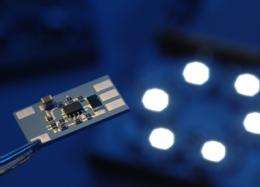Magnetic ceramics films for smaller transformers

Siemens is developing magnetic ceramic films so that the high-performance electronic circuits used in lighting systems and other such devices can be made smaller and much easier to manufacture. This type of circuit adapts the voltage, current, and frequency to the electrical consumer, for instance, a lamp.
In order to save space, as many components as possible — resistors and coils, for example — are incorporated into the individual layers of ceramic printed circuit boards, thus creating metallic surfaces or conductors. Until now, however, it has been difficult to embed magnetic cores, like those used for transformers, into ceramics. The new film solves this problem, thus saving space in car headlights that use discharge lamps, for example. Such headlights are fitted with ballasts to create the high voltage needed for generating light. The new system would make it possible to incorporate the ballast directly into the lamp in the future.
Transformers change the current and voltage of alternating current. They consist of a closed magnetic core with two windings. If the component is incorporated into a printed circuit board, the windings are created in two of the board’s layers and the magnetic core is installed into a drilled opening. Doing this in ceramic printed circuit boards is a very complicated and expensive process because the magnets and ceramics expand differently when heated, making separate sintering or firing procedures necessary.
However, the researchers at Siemens have now developed a magnetic ceramic film which is laid on the transformer winding between the printed circuit board’s individual layers, where it takes over the function of the magnetic core. The ferrite film is only a few tenths of a millimeter thick and can be fired together with the ceramic circuit board in a single process step at less than 900 degrees Celsius. A transformer embedded in this manner and having an edge length of about 1.5 to two centimeters and a height of 1.5 millimeters transfers an output of 120 watts at a frequency of 2.5 megahertz.
The new, flat high-frequency transformer technology is designed for applications in which space is at a premium and ambient temperatures are high. In addition to being used for lighting and industrial applications, the new film can overcome the difficulty posed by simultaneous inductive transmission of energy and of sensor and control signals between otherwise incompatible printed circuit board technologies for high-performance and control electronics. Among the beneficiaries of the new film are quick-charging systems for electric cars. Such systems have to handle currents of about 100 amperes while providing power to the communication units linking the charging station with the battery. The German Federal Ministry of Education and Research is helping to fund the film’s development.
Source: Siemens

















